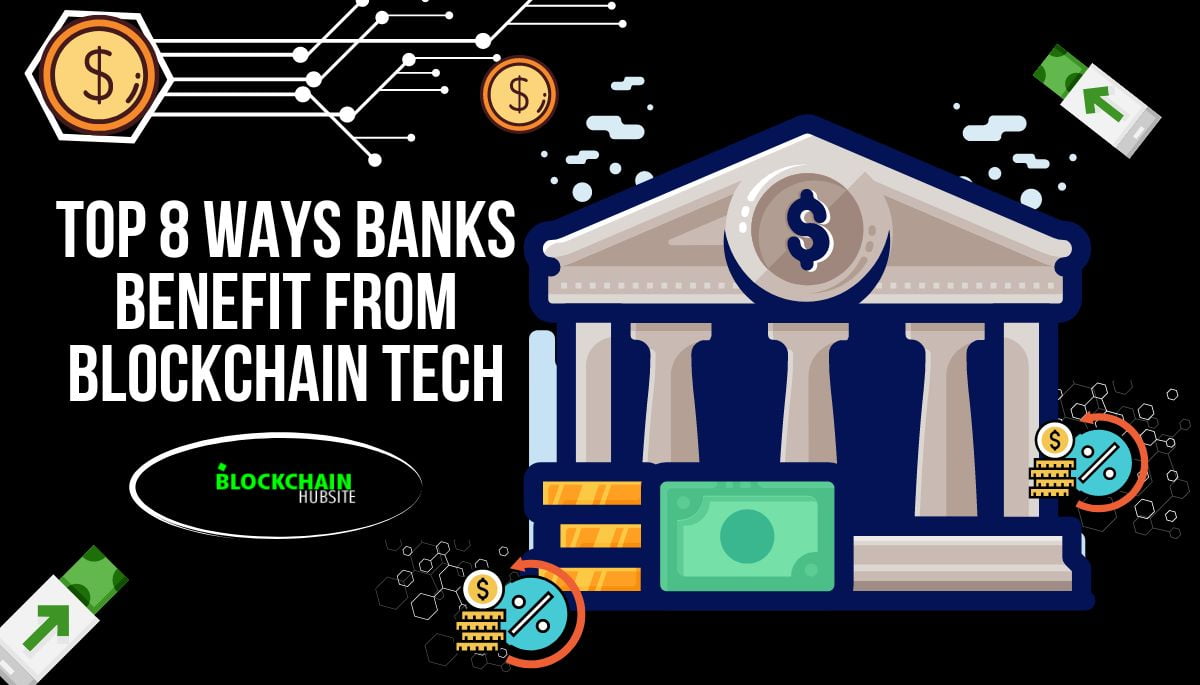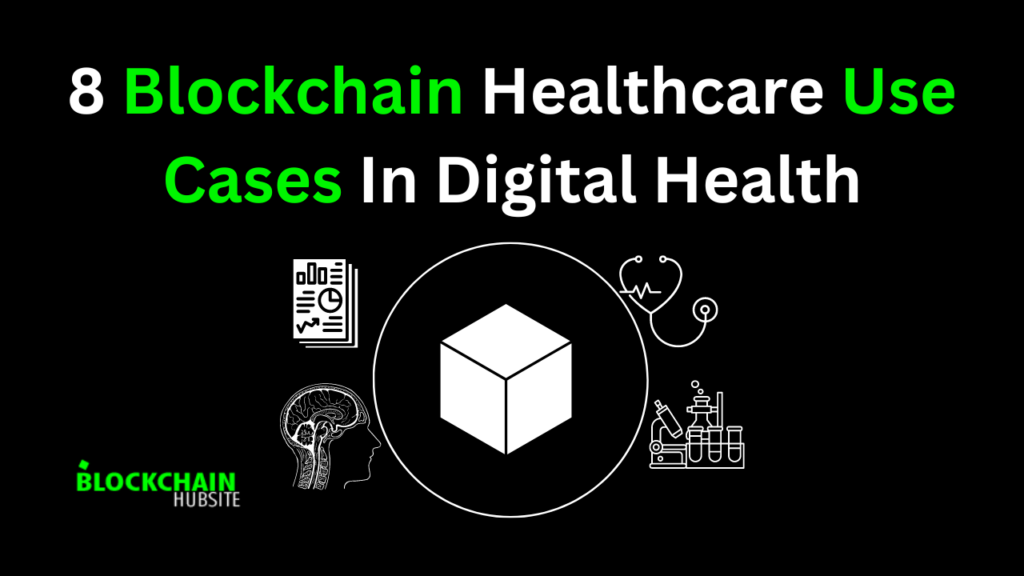
Table of Contents
There are 8 Ways Banks Benefit From Blockchain Tech that highlight the immense transformative potential thisemerging technology has for reinventing banking operations and services. Blockchain is a decentralized, distributed public ledger that securely and openly records peer-to-peer transactions. Although sometimes linked to cryptocurrencies, blockchain technology has uses in the financial industry, particularly for banks.
Blockchain gives banks a shared, unchangeable transaction data available to all network participants. The decentralized, transparent ledger system eliminates the need for intermediaries by establishing accountability, trust, and process integrity. Moreover, native blockchain features like encryption, consensus methods, smart contracts, and others increase productivity, security, and control.
Banks are increasingly adopting blockchain technology as it progresses from being the foundation of cryptocurrency systems to enterprise-grade solutions for global banking. Prominent financial institutions and technological innovators are testing diverse blockchain embeds, integrations, and applications to manage banking functions, from customer onboarding to international transfers. The intrinsic capacity of the technology to maximize auditability, automation, transparency, and other features promises to revolutionize the way banks move, hold, and manage value.
This article will explain the 8 most significant ways banks can gain by adopting blockchain technology and reorganizing their operations to capitalize on the advantages of distributed ledger technology.
Understanding Blockchain Infrastructure and Functionality

Blockchains are decentralized digital ledgers that effectively and securely record transactions between parties. They comprise cryptographically linked blocks of immutable transaction data that are connected to form a chain.
Every block collects and records transactional data, including the date, time, wallet addresses involved, and the amount moved, but it does not reveal any personally identifiable information. Instead, users employ digital signatures in the form of automatically produced public-private key pairs to facilitate verified yet pseudo-anonymous blockchain participation.
Every block also includes a cryptographic hash code, differentiating it from other blocks. Blockchains can immutably preserve ownership records and transaction history across a peer-to-peer network thanks to this chain of chronological, hashed, and encrypted blocks containing transaction data.
When a single user executes many transactions, for example, each transaction will result in a distinct block with a unique hash verifying the execution. Block sizes can hold up to 1 MB of data and retain anywhere from a few hundred to a few thousand transactions, depending on the blockchain. Blocks are added to the chain when transactions occur, creating a historical record that is viewable by authorized network users.
Blockchain’s Transformative Impact on Banking

In recent years, blockchain
has significantly developed in financial and other industries. Blockchain eliminates the need for a middleman organization to conduct transactions by enabling untrusted parties to agree on the current state of a shared database.
The technology creates a distributed, decentralized ledger not managed or controlled by a single organization. This eliminates the need for banks or payment processors to act as middlemen and allows blockchain networks to provide financial services, including payments, clearing, and settlements.
Therefore, rather than just tracking money flows, banks can reallocate resources to higher-value operations thanks to blockchain’s introduction of true decentralization. Numerous facets of banking have undergone fundamental evolution because of blockchain technologies. The major areas affected are payments, settlement systems, financing techniques, securities administration, loans, credit provisioning, and trade finance.
Regarding payments, blockchain offers cheaper rates and faster money transfers than traditional bank wire transfers. Distributed ledger technology allows real-time settlement between institutions and lowers operational risk and expenses for post-trade settlements and clearance.
Initial Coin Offerings (ICOs), a blockchain-powered capital raising strategy that separates funding from investor services, have revolutionized fundraising. On blockchain-based platforms, tokenization and instantaneous, round-the-clock asset exchange have also improved securities trading.
Smart contract-based lending eliminates the need for gatekeepers and can enhance loans and credit provisioning. Lastly, electronic paperwork, increased exporter-importer openness, and blockchain-based automated international payments have all benefited trade finance.
Top 8 benefits of blockchain
Blockchain technology can help banks improve customer service standards, security, efficiency, and financial processes. Banks are highly motivated to incorporate distributed ledger technology as it progresses from serving as the foundation for cryptocurrency transactions to broader uses in commercial finance.
Blockchain offers desired enhancements in speed, automation, security, transparency, and tamper-proof decentralized record-keeping of transactions on a shared ledger for financial operations. The inherent benefits of blockchain technology in fostering accountability, trust, and process integrity are a natural match for many of the issues financial institutions face.
1. Optimizing Infrastructure Costs

By implementing blockchain-based systems, banks may save a lot of money on overhead and infrastructure costs. By facilitating smooth digitalization, automation, and integration, blockchain optimizes manual back-office operations and workflows.
By systemizing processes like payment settlements, compliance protocols, escrow agreements, and other contractual payouts or transfers, smart contracts significantly reduce resource expenditure. By incorporating intricate legal and business reasoning into autonomous software applications, smart contracts eliminate the necessity for intermediaries, outside consultants, and reconciliation endeavours.
One significant cost savings comes from using blockchain-powered digital document and instrument registries to replace laborious paper trails. This immediately reduces the cost of handling, storing, and validating documents. The unified view of transaction data also facilitates complicated accounting reconciliation and double invoice processing.
In addition, decentralized blockchain consensus among banks replaces settlement providers and centralized clearing houses; globally distributed peer-to-peer validation permits real-time settlement finality rather than batch progress through intermediaries.
By 2022, it was predicted that blockchain would have saved banks over $20 billion on infrastructure expenses. The most significant savings came from simplifying clearing and settlements ($12 billion), streamlining trade finance procedures ($5 billion), and lowering compliance expenses ($3 billion). For banks, this makes integrating blockchain technology a very affordable option.
2. Accelerating Transaction Speed

Blockchain technology allows banks to clear and settle transactions—transfers, payments, and trades—in real time, significantly speeding up transaction times. Without blockchain, bank transactions usually require several time-consuming internal backend systems and external middleman validation, reconciliation, and approval stages before being finalized.
Distributed ledger technology, on the other hand, uses decentralized consensus among network nodes to verify transactions almost immediately. This replaces the conventional centralized clearing techniques that need batch approvals or reliable third parties. Due to the peer-to-peer structure of blockchain and its cryptographic security protocols, counterparties can swap assets and money instantly rather than over days.
Similarly, blockchain-based atomic swaps or tokenization can provide same-day or instantaneous finality for securities trades that typically take two to three days to settle in traditional markets. These time savings come from using smart contracts on such blockchain platforms for automated verification, disintermediation of centralized exchanges, and straight-through processing.
This eliminates processing and transfer delays caused by single points of failure in legacy systems. As a result, banks that use blockchain technology can offer their clients previously unobtainable levels of responsiveness for payments, asset transfers, withdrawals, and deposits.
3. Bolstering Data Security

Blockchain provides banks an incredibly secure infrastructure for asset transfers and transaction data storage. Because it is decentralized, it does away with the central points of failure that hackers target in traditional banking IT systems.
Blockchain protects data via distributed storage over global peer-to-peer networks, immutable ledger records, and encryption. Historical documents are impenetrable because of sophisticated cryptographic mechanisms like hash functions, digital signatures, and Merkle trees. Modifying past transactions renders subsequent records invalid, making fraud almost impossible.
To provide security guarantees, blocks holding transaction data are additionally connected using intricate mathematical sequences. Additionally, ownership is assigned by required public-private key pairs, which give non-repudiation and improved accountability. While the public key verifies the sender’s identity, the sender must sign transactions using the private key.
Proof-of-work and other consensus techniques encourage a dispersed network of miners to invest computational power to validate and append transactions adhering to stringent guidelines, further securing blockchains. It is possible to ensure data integrity without centralized intermediaries by decentralized validity confirmation between untrusted parties. Tampering necessitates controlling at least 51% of the peer-to-peer network, which is practically impossible.
Blockchain provides security at the core infrastructure level significantly more potent than any defences conceivable in conventional financial systems. Thus, financial institutions can safeguard client deposits and give customers confidence about their data security.
4. Enhancing Transparency

Blockchain significantly increases banking operations’ transparency, which benefits reporting, compliance, and auditability. It gives authorized managers and compliance personnel access to a shared ledger that offers real-time visibility and accurate record-keeping.
It is also possible to efficiently conduct internal and external financial authority audits of past account operations thanks to the entire history of past transactions. Reliable compliance reporting about fund flows, asset ownership, transaction histories, and other information required by regulators is made possible on an unchangeable, visible basis.
Banks themselves see an increase in transparency as information gaps caused by outdated systems are eliminated across business units. Complex data reconciliation projects are no longer necessary when data becomes naturally consistent. Eliminating these inefficiencies helps managers make data-driven decisions, improves risk-based pricing accuracy, and gives them more visibility over banking operations.
5. Mainstreaming Digital Assets

Thanks to blockchain technology, banks can incorporate support for cryptocurrencies and digital tokens through public or private distributed ledgers. This makes it simple to put safe business procedures for transactions involving digital assets into place.
Protocols that enable the production of unique cryptocurrencies or tokens that represent everything from fiat money to securities like stocks and bonds are established by public blockchains like Ethereum and Bitcoin. With this functionality, banks can offer digital currency accounts, tokenized traditional asset trading, and cross-border forex transactions. Smart contracts can also be used to program additional logic into them.
Many financial institutions already use stablecoins—cryptocurrencies backed 1:1 by fiat deposits to reduce volatility—in experimental programs. Stablecoins allow users to benefit from the speed and transparency of blockchain technology while efficiently transacting for payments, transfers, and other banking needs.
Meanwhile, institutional-grade solutions for limited participation can be developed thanks to suppliers’ permissioned corporate blockchains. Banking consortiums can use them for programmable money and mainstream tokenized assets with built-in automation for private distributed ledgers.
In general, native blockchain features enable banks to easily accept digital assets and currencies, which are the unavoidable direction of the financial industry.
6. Embedding Accountability

Because blockchain records transactions immutable, it inherently encourages accountability in banking. The inability to change transaction records makes it simple to conduct audits to find the origins of inconsistencies or errors.
Unambiguous traceability identifying who performed what and when is provided by the end-to-end trail demonstrating the origin of assets. To promote transparency, any approved user on the blockchain network has access to view this activity trace.
By minimizing differences between parties, such well-defined and immediately accessible transaction records establish strict accountability of activities. The immutability of transactions signed by a bank representative is ensured by cryptography, hence removing the potential for altering reporting.
By integrating strong accountability measures into the infrastructure that supports banking operations, organizations may lower the risk of non-compliance and encourage accountability across internal teams. Moreover, management supervision of authorized signatories gets better. Distributed ledger records show definite, consistent, and up-to-date sources of responsibility.
7. Facilitating Compliance

There are several ways that blockchain simplifies compliance for banks. Firstly, entries on distributed ledgers are permanent, making it easy for internal compliance teams or outside supervisory bodies to audit previous transactions.
Such transparent, unchangeable histories can be made available to regulators to quickly check financial reporting, look into irregularities, and judge compliance with customer identification or anti-money laundering regulations. Additionally, shared datasets enhance agency-to-agency collaboration.
Furthermore, smart contracts enable real-time anomaly identification and risk management by integrating compliance rulesets directly into transaction execution processes. Suspicious fund transfers or trades are immediately flagged for inquiry by a code that represents regulatory requirements.
Moreover, using oracles, banks integrate with external data sources such as fraud databases, politically exposed person directories, and sanctions lists. This enables the proactive banning of illicit transactions.
So, compliance becomes deeply ingrained in operations to stay up to date with evolving policies. Obtaining necessary transaction data from blockchain-based systems makes it easier for banks to submit periodic reports and provide evidence to pass audits.
8. Minimizing Reconciliation

Complicated reconciliation operations are frequently required when there are discrepancies between banking counterparties’ information about trades, payments, or other data. This results in significant overheads, delays, and hazards.
In contrast, there is less need for reconciliation when definitive transaction datasets and asset registries are distributed on shared ledgers. Additionally, smart contracts properly define agreements between several banks’ parties, guaranteeing a shared understanding of rights and responsibilities.
Banks avoid conflict with counterparties since they can access a single version of reconciled, standardized data. Blockchain systematization results in a significant reduction in manual verification and communication costs.
Derivatives, swaps, and other complex transactions are carried out using smart contracts that self-reconcile in real time, reducing errors and modifications. Reliability in the execution of automated reconciliation reduces accounting disparities for assets.
Reconciliation efforts may decrease by 50–70% overall, giving institutions a significant boost in efficiency and cost savings. Integrated transparency measures that identify reconciliation gaps also facilitate exception management.
Conclusion
By leveraging decentralized, distributed ledgers, blockchain technology improves bank security, transparency, speed, and cost structures. Consensus-verified transactions improve process integrity and accountability in the financial industry. Tokens and cryptocurrency enable more services that are future-proof.
While there are initial challenges with integration and education, blockchain holds great potential for long-term benefits, such as simplifying compliance and modernizing infrastructure. Blockchain technology may become widely accepted as the reliable backbone of next-generation banking networks due to quantifiable changes being realized.
FAQs
1. What are the benefits of blockchain to banks?
Blockchain enables faster, cheaper transactions through process automation and disintermediation. It also enhances security via decentralized encryption and the transparency of transaction data.
2. Why blockchain is becoming a popular technology for mainstream banking?
Blockchain is gaining popularity in banking due to its ability to reduce costs, improve transaction speeds, and enhance security. The decentralized and transparent nature of blockchain builds trust, eliminates intermediaries, and deters fraud.
3. How blockchain will impact the banking industry?
Blockchain promises to transform banking by enabling real-time settlements, lower costs, improved security, and financial inclusion. However, adoption requires massive technology investments and process changes, so banks must strategize to harness benefits while navigating disruptions.
4. How would blockchain technology reduce the costs of banking?
Blockchain would reduce banking costs by streamlining and automating back-office processes. By establishing a single source of truth, it eliminates reconciliation and reduces fraud and errors. Smart contracts facilitate real-time settlements without middlemen. Overall, blockchain optimizes operations and allows banks to save on infrastructure and labor.
5. What is the JP Morgan blockchain?
JP Morgan’s blockchain platform is called Onyx. It facilitates payments between large institutional clients on a custom-built distributed ledger that interfaces with existing banking rails. Onyx provides real-time movement of money and transparency in transactions between parties, aiming to optimize efficiency and cost savings in banking processes.




